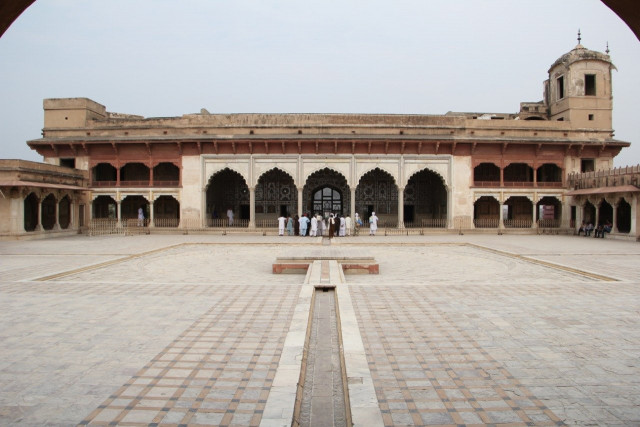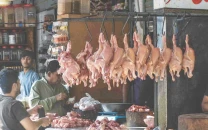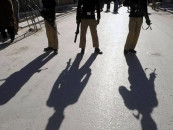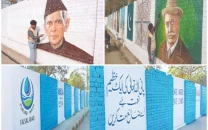Lahore Fort – a historical gift that keeps on giving
Part of the fort, where structures built during Akbar's era were situated, now has residences of fort’s staffers

PHOTO: Express
Even so, a recent visit conducted by a historical conservation team unearthed a large number of hitherto undiscovered rooms and priceless Mughal artifacts. The sections recently discovered by the team, led by Director Conservation of Lahore’s Walled City Najamul Saqib, include a royal kitchen, a royal bath thought to belong to Mughal emperor Akbar, lockers under the black bridge, the Maisam Gate and a gunpowder storehouse. Meanwhile, experts have managed to renovate and restore the jewel in Lahore Fort’s crown, the world’s largest picture wall.
Part of the fort, where structures built during Akbar's era were situated, now has residences of the fort’s staffers.
“[The fort is so rich in history that] structures built during Akbar's era might still be buried under the residential colony as many signs of the royal bath, its age and design can be observed near the residential quarters,” Saqib said.
According to Punjab Heritage Department Director Afzal Khan, the ground in front of the Dewaan-e-Aam was excavated in 1959 with assistance from international archaeological experts. The excavation led to the discovery several site structures belonging to thirteen different eras.
Since the fort was built on muddy surface, several artifacts have been buried under the ground over time, while new structures were constructed atop them.
“If more parts of the fort are excavated, there are chances of discovering more,” Afzal Khan said. “However, it must be noted that, so far, no secret trenches have been discovered at the fort.”
He further explained that adjacent to the walls of the fort, there were rooms and corridors constructed under the ground which were used to connect various buildings of the fort.
“The signs of such rooms and corridors have been falsely rumored to be secret trenches of the fort leading to an exit. Some people used to believe that these trenches were extended all the way to Delhi but all such claims are only based on hearsays and have no proof of reality,” Afzal Khan clarified.
According to experts, only 20 to 25 per cent of the Royal Fort has been discovered and there is still a lot more to find out.
“The fort is a treasure trove of history, therefore, it will remain a subject of curiosity and great interest for architectural historians and archaeologists for a long time,” Afzal Khan said.
“It may take several years to fully unearth the signs of many lost civilisations that once resided herein.”
The magnificent structure, which is 1100-feet high and 1115-feet wide, was originally built to protect it against external threats. Per a tradition, the fort and the city of Lahore were built in between 200BC and 80BC upon the orders of Loh – the son of Raja Ram Chandar.
In 1959, the heritage department ordered the excavation of the ground in front of the fort upon which archaeologists discovered a gold coin dating back to 1025 AD from the era of Sultan Mehmood Ghaznavi.
Further excavation of the ground led to the discovery of artifacts which proved that the fort was present even before the arrival of Sultan Mehmood Ghaznavi. It was also found out that Lahore Fort was also present during the battles of Sultan Shahabuddin Ghori.
A symbol of different invasions and reigns
In 1241, the fort was destroyed by the Mongols after which it was rebuilt by Ghiyasuddin Balban in 1267. In 1398, the army of Amir Taimur also stormed the fort which ruined a sizable portion of the structure. However, Sultan Mubarak Shah Syed rebuilt the fort with clay in 1421. In 1432, the fort had a turn of fate again, as it was captured and renovated by Shaikh Ali from Kabul.
However, the current structure of Lahore Fort – constructed with bricks – was renovated during the reign of Mughal Emperor, Jalaluddin Muhammad Akbar in 1568. The remake restored the structure to its original design and, at the time, it was extended over a large area, so much so that it touched the bank of River Ravi toward its North.
Until 1849, The Ravi used to flow adjacent to the northern wall of the fort. The revamped structure built during the reign of Akbar included a royal palace for the Mughal King, a royal as well as public treasury, a Jharoka Darshan balcony and a mosque gate.
The rulers that came next added more buildings and features to the fort. Mughal King Jahangir made a new treasury which he named “Ahata Jahangiri” along with a library, while in 1631, Shah Jahan ordered the construction of Deewan-e-Aam (a public court) and Sheesh Mahal.
Similarly, in 1633, further additions were made to the fort, including rest houses, royal baths and apartments. In 1645, Deewan-e-Khas (special courts) were built while Moti Masjid was also probably built during the same year. In 1674, the Alamgiri Gate was built in the fort upon the orders of the Mughal King, Alamgir.
Between 1799 and 1839, Mahraja Ranjeet Singh ordered the development of the fort’s external walls, together with eight gates (Aath Dara), which included Haweli Mayi Jandaan, Haweli Kharak Singh and Baradar (eight gates) for Raja Dehan Singh.
During the era of Mahraja Ranjeet Singh, precious stones were also engraved on various walls while some parts of the fort were demolished.
In 1846, the British – who had taken over the subcontinent in 1858, decided to demolish the southern walls of the fort and replace them with staircases. In the process, they removed the protective boundary of the fort. To ensure the protection of the fort, the British set up trenches at various points of the fort's boundary --- each trench having three gates for entry and exit. In 1927, the control and administration of the Lahore Fort was handed over to the heritage department.
At present, the Royal Fort does not have any building structure predating the Mughal era. The premises built during the Mughal rule has been distributed into four big parts comprising 21 buildings which reminisce of different kings and their reigns over the past 500 years. Each building has a unique design and structure, while the most notable buildings in the fort include Sheesh Mahal, Dewan Khas, Dewan Aam, Moti Masjid, Dolat Khana Khas o Aam, Khwabgah Shahjahani and the largest picture wall of the world.



















COMMENTS
Comments are moderated and generally will be posted if they are on-topic and not abusive.
For more information, please see our Comments FAQ